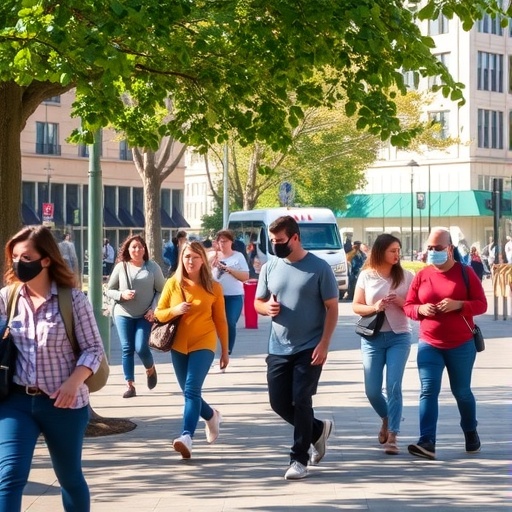DURHAM, N.H.—(August 21, 2025)—In an illuminating new study emerging from the University of New Hampshire, researchers have uncovered compelling evidence linking neighborhood walkability to significant reductions in the mental health toll experienced during the COVID-19 pandemic. The investigation analyzed data on community design and individual well-being at an unprecedented scale, revealing that even modest improvements in the ease with which residents could walk in their neighborhoods were associated with notably better mental health outcomes amid one of the most challenging public health crises in recent history.
The COVID-19 pandemic’s multifaceted impacts on mental health have been widely documented, yet the environmental and infrastructural factors moderating those effects remain less understood. Lead author Karen Conway, a professor of economics at UNH’s Peter T. Paul College of Business and Economics, highlights how access to outdoor spaces for walking acted as a critical buffer against pandemic-related stress. Conway recounts personal experiences during the pandemic where daily walks enabled social connection and relief from isolation, underscoring the vital psychological role played by walkable surroundings.
The research team, including co-author Andrea K. Menclova from the University of Canterbury, deployed sophisticated analytical methods combining national census data, health surveys, and walkability metrics from the Environmental Protection Agency’s (EPA) Walkability Index. This index, ranging from 0 to 20, quantifies how conducive a neighborhood’s infrastructure is to pedestrian activity based on factors like street connectivity, land use, and accessibility to amenities. Their findings indicate that a mere four-point increase on this scale corresponds to an approximate four percent reduction in average mental health deterioration attributed to pandemic stressors.
To contextualize these results, the study describes neighborhoods scoring below six on the Walkability Index as having low pedestrian accessibility, whereas communities scoring above 15 exhibit highly walkable urban designs. This delineation underscores how urban planning characteristics translate into tangible public health implications. The analysis spanned over 55,000 census tracts across the United States, leveraging granular intra-county comparisons to control for broader cultural and environmental variables and isolate the specific influence of neighborhood walkability.
By examining mental health trends from before the pandemic (2018–2019) alongside data collected during the pandemic (2020–2021), the researchers were able to assess temporal changes while accounting for local pandemic severity and policy differences. This approach permitted a nuanced understanding of how identical macro-level shocks could yield heterogeneous mental health impacts shaped by micro-level environmental factors such as walkability. The within-county comparison was critical to controlling confounding variables that often plague population health studies.
The protective mechanism of walkable environments appears multifactorial. First, walkability facilitates regular physical activity, which has long been associated with improved mood and resilience against depression and anxiety. Second, increased time spent outdoors exposes individuals to natural light and green spaces, factors known to positively influence psychological well-being. Third, walkable neighborhoods promote incidental social interactions—small yet meaningful exchanges that help maintain social cohesion and support, even under conditions of physical distancing and social restriction.
Interestingly, the study notes a paradoxical decline in walking for traditional purposes such as commuting and transportation during the pandemic, replaced by an uptick in leisure walking predominantly near residents’ homes. This shift amplifies the importance of immediate neighborhood environments in sustaining physical and mental health when broader mobility is restricted. The alignment of increased leisure walking with higher walkability scores further substantiates the functional role of pedestrian-friendly design in mitigating pandemic-related mental distress.
Beyond the immediate context of COVID-19, the implications of this research extend to a wide array of stress-inducing life events such as grief, divorce, job loss, and chronic everyday anxiety — all of which contribute substantially to the public mental health burden. The findings advocate for urban planning and public health strategies to prioritize walkability enhancements, including infrastructure investments like sidewalks, traffic calming measures, and improved pedestrian connectivity, with the goal of fostering resilient communities equipped to buffer against psychological stressors.
This study contributes a data-driven rationale for integrating walkability metrics into urban policy frameworks, shifting the conversation from purely aesthetic or environmental considerations to a holistic public health imperative. It strengthens the growing body of evidence that human-centered urban design is indispensable not only for physical health but for mental and social well-being as well, particularly in times of crisis. The cross-disciplinary approach combining economics, public health, urban planning, and behavioral science exemplifies the complex challenges and solutions at the nexus of built environments and mental health.
While the protective effects identified are robust, the authors acknowledge limitations including the inherent correlational nature of their analyses and the need for further research to unravel causal pathways and explore intervention studies. Nonetheless, their comprehensive approach leveraging large-scale datasets and fine-grained spatial analysis marks a significant advancement in understanding how modifiable local environmental features can serve as public health levers during pandemics and beyond.
In sum, the University of New Hampshire study underscores that the ability to step outside and traverse walkable neighborhoods confers more than physical benefit—it offers a scientifically validated mental health shield during times of profound societal disruption. As cities and towns chart recovery and resilience in a post-pandemic era, embedding walkability into the fabric of communities emerges as a cost-effective, equitable, and scalable strategy to nurture collective well-being.
Subject of Research: The impact of neighborhood walkability on mental health outcomes during the COVID-19 pandemic.
Article Title: Walkability as a Protective Factor Against Pandemic-Related Mental Health Deterioration: Evidence from U.S. Census Tracts.
News Publication Date: August 21, 2025.
Web References: https://onlinelibrary.wiley.com/doi/10.1002/hec.70013
Keywords: Behavioral economics, Quarantines, Mental health, Human health, Public health, Disaster management, Public policy, Stress management




